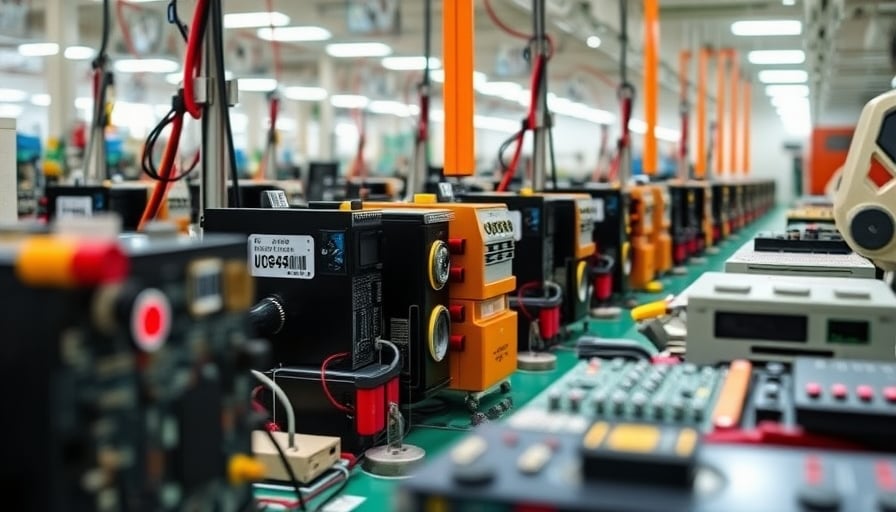Huagong Tech Co. Ltd.: Riding the Electronics Surge While Facing Valuation Risks
Huagong Tech Co. Ltd. (Huagong) has been a quiet contender in Wuhan’s burgeoning technology scene, offering laser equipment, optical‑telecommunication products, and a diverse array of electronic components. Its share price closed at CNY 81.02 on 23 October 2025, a modest 20 % rise from the 52‑week low of CNY 32.33 but still far from the sector’s peak of CNY 100.89 a month earlier. With a market capitalization of CNY 80.7 billion and a price‑earnings ratio of 50.67, the company sits at the upper end of valuation multiples typical for China’s high‑tech manufacturers.
1. Industry Momentum Fuels Huagong’s Growth Narrative
The recent trading day, 24 October 2025, witnessed a substantial net inflow of RMB 219.58 billion into the A‑share market, the largest share of which was directed toward the electronics sector. The sector surged 4.72 % that day, attracting RMB 223.92 billion in capital. This influx reflects a broader shift among institutional investors toward electronics and semiconductors, sectors that are the backbone of China’s “Made In China 2025” agenda.
Huagong, whose product line includes electronic components and optical devices, stands to benefit from this trend. The company’s inclusion of “laser equipment” and “optical telecommunication products” aligns it with the high‑growth subsectors that have attracted the bulk of the day’s inflows. In addition, the firm’s ancillary services—computer software development and system integration—provide a recurring revenue stream that is less sensitive to commodity price swings.
2. Weak Equity Exposure in a Volatile Market
Despite the bullish sector backdrop, Huagong’s share of the market’s equity exposure remains tenuous. The fund that most closely tracks Huagong’s peers, Jianxin Xin‑Sheng “Stable‑Return Flexible‑Allocation” Hybrid A, posted a net profit of CNY 0.9748 million in the third quarter of 2025. Its net‑value growth rate of 3.34 % pales in comparison to the 30.81 % gain of the Jianxin Heng‑Sheng Tech Index Fund, a QDII product that focuses on technology. Furthermore, Jianxin’s average stock position stood at only 19.89 % during the same period, far below the 72.18 % average of comparable funds.
The stark disparity underscores a defensive posture among fund managers toward high‑valuation technology names. If institutional investors continue to adopt a “core‑plus‑satellite” strategy with a lean equity tilt, Huagong’s upside potential may remain constrained, despite the favorable industry climate.
3. Valuation Concerns and Revenue Sustainability
The company’s P/E of 50.67 is a glaring outlier when compared to its peers in the electronic‑equipment space, many of which trade below a 30× multiple. Even when adjusted for revenue growth, Huagong’s gross margins have shown only incremental improvement, a trend that can erode profitability in the face of intense price competition.
Moreover, the company’s heavy reliance on capital‑intensive manufacturing and its limited presence in high‑margin biotech segments expose it to cyclical demand shocks. The absence of a robust, diversified revenue stream could prove detrimental if the electronics sector experiences a slowdown or if raw‑material costs surge.
4. Strategic Implications for Investors
Investors should weigh the following points:
- Sector‑wide Momentum vs. Company‑specific Fundamentals – While electronics is attracting institutional capital, Huagong’s valuation and earnings profile lag behind the broader trend.
- Capital Allocation Discipline – The conservative equity stance of leading funds indicates a cautious outlook toward high‑PE names, potentially limiting upside.
- Revenue Diversification – The company’s reliance on core manufacturing without a clear path to high‑margin services could limit long‑term growth.
- Risk of Market Correction – A pullback in the electronics sector may hit Huagong harder due to its valuation premium.
In conclusion, Huagong Tech Co. Ltd. is positioned at the intersection of a booming electronics market and a high‑valuation risk premium. While the sector’s momentum offers a tailwind, the company’s fundamental constraints and the cautious stance of institutional investors suggest that the stock’s current price may be overextended. Investors should monitor the company’s ability to translate sector demand into sustainable earnings growth before committing significant capital.
